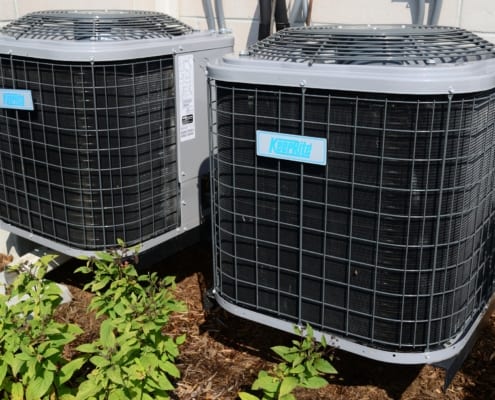Homes can slowly turn into money pits if you fail to maintain and upkeep the structure regularly. For homeowners, maintaining the home year-round will prevent costly repairs from happening in the future, and also make the house more attractive for prospective home buyers. In the hot summer months, failing to upkeep the house can lead to all sorts of expensive damage. As they often say, an ounce of prevention is worth a pound of cure.
If you own a home, you’ll need to keep these top eight home maintenance tips in mind for the summer season. First, we’ll start with the interior of the house.
1. Safety First: Check the Smoke Alarms and Carbon Monoxide Detectors

The smoke alarms and carbon monoxide detectors are vital to your safety, but we hardly ever think about them. The first thing you should do on your summer home maintenance agenda is to check to make sure they are working correctly. Replace the batteries if needed, and run a test just to be safe.
2. Prepare the home’s cooling system and fans

A properly working air conditioner isn’t just for comfort. Before the invention of indoor cooling systems, young children, the elderly, and people with certain health conditions died from stifling, dangerous heat levels. In many parts of the world, air conditioning isn’t just a luxury. It is a must for the occupants’ safety. After you’ve done a thorough check of your smoke alarms and carbon monoxide detectors, it’s time to make sure the AC unit is working.
First of all, you’ll probably need to contact a professional to have the unit serviced. Poorly working AC units can waste energy and lead to an unexpected, sky-high electric bill. And the last thing you need is to have the AC go kaput during the peak of a heatwave. Always change the filter before running the AC for the summer season. Making sure the AC unit is in good working condition will also ensure that it lasts a long time, keeping you and your family cool, comfortable, and safe in the summer heat.
Ceiling fans will also help to circulate cool air and keep everyone comfortable. Turn them on and make sure they are working, and dust the blades. You might also need to change the direction of the blades, too. You want the fans to spin counterclockwise. That way, they push the air downward, keeping the rooms cooler. If your fans are turning clockwise, you’ll want to find the direction switch on the side of the fan to switch it to the other direction.
3. Check the attic and the basement

Spring and early summer are the perfect time to do a little home inspection of the basement and the attic. Check the basement for signs of mold, leaks, and mildew. If your basement walls appear damp or mold-infested, you can clean them with white vinegar or a bleach mixture, then apply a mold-killing spray to the area. Consider running a dehumidifier in the basement to eliminate moisture and prevent mold from regrowing.
In the attic, look for signs of pests or leaks in the roof. The health of the roof will have a direct impact on the structural integrity of your house. Any signs of pests or holes in the roof need to be dealt with immediately. Contact a reputable pest control company or a roofing contractor to take care of these issues before they turn into big problems.
Read More: Spring Maintenance Tips
4. Do a thorough cleaning of the home’s internal systems

Clean the air vents, since dust and other allergens can accumulate over the winter and irritate everyone’s sinuses. Run a damp cloth over the baseboards of the house, and clean and dust the bathroom vents. Replace the showerheads if needed, and clean the bathroom and kitchen sink drains.
If you have a chimney, now is the perfect time to clean it out. Over the winter, the outside of the chimney can form tiny cracks, holes, and crevices for water ingress. Get the chimney flashing fixed to prevent costly leaks and mold growth from forming now that summer is on its way. The chimney liner may need to be replaced as well. It’s easier and cheaper to get a chimney looked at and serviced in the spring and summer months as opposed to fall and winter.
For the outside of the house, keep these tips in mind to get the exterior of the home clean and summer ready.
5. Wash the windows and doors

Clear, sparkly windows and doors can brighten up the home’s exterior and the interior as well. A clean facade will also inspire confidence in potential buyers if you’re planning to put your house up for sale this year. You’ll want to remove the screens and soap them down separately with a sponge. Any torn screens should be replaced. Clean off any leaves, twigs, and cobwebs from the sills, then wipe down the outside and inside of the window glass with a high-quality, streak-free window cleaner.
6. Gussy-up the deck and the porch

First, you’ll need to clear the area of furniture, then sweep off the porch and deck. Once the deck and the porch are clear of furniture and debris, you can thoroughly inspect them for signs of impending maintenance issues. Look for rotting boards that may need replacing, and hammer down any nails that have come loose and are sticking up. It’s also a good idea to check and see if your deck or porch needs resealed.
Spray down the area with a garden hose, or pour a bucket of water on the area. If the water beads into small puddles, then the deck does not need to be resealed, so you can breathe a sigh of relief. But if the water soaks into the wood, you’ve got a problem, and you’ll need to get the deck resealed pronto. Otherwise, those boards are going to rot and cause major headaches in the near future.
Once you’ve taken care of the structural integrity of the porch and the deck, it’s time to wash it with a high-quality cleaner and scrub away any stuck on dirt and grime.
7. Inspect the outside faucets and hoses for leaks

Hoses with pinhole leaks can be temporarily repaired with black electrician’s tape. Wrap the tape around the hose when it is dry to stop the leak and get another summer’s worth of life out of the hose. Any leaking faucets will need tightened up or replaced, depending on the extent of the issue.
8. Clean the gutters and downspouts

The gutters and downspouts keep water from pooling on the roof or near the foundation. It’s critical that these parts of the house are clear of debris and in good working order. Replace any sections of the gutters or downspouts that are damaged, and clean the gutters of leaves, twigs, and other debris. This should ideally be done in the late spring, and again in late fall.
Summer only comes once a year, and the spring months leading up to the blazing hot summer are the perfect time to get your house in tiptop shape. Take the time to inspect and maintain your home this summer so you can sell it quicker and command a higher price for your well-maintained property.
 https://www.grayslakehomeinspections.com/wp-content/uploads/sites/35/2024/07/Picture3.png
416
624
johnreim
https://d3bfc4j9p6ef23.cloudfront.net/wp-content/uploads/sites/35/2018/10/02163451/Logo-trans200-300x173.gif
johnreim2024-10-03 15:51:552024-11-09 18:14:17The Importance of Inspecting Roofs and Gutters
https://www.grayslakehomeinspections.com/wp-content/uploads/sites/35/2024/07/Picture3.png
416
624
johnreim
https://d3bfc4j9p6ef23.cloudfront.net/wp-content/uploads/sites/35/2018/10/02163451/Logo-trans200-300x173.gif
johnreim2024-10-03 15:51:552024-11-09 18:14:17The Importance of Inspecting Roofs and Gutters












